Abstract
Object of research of this article was application of the form of histograms of distribution of brightness of pixels as a sign vector for classification of images with persons. Within the task of recognition it is considered that to every image the unique value of a vector of signs is put in compliance. Vectors of images contain all information on an image striking to coding and are considered as n points – a measured Euclidean space. Classification of images was carried out by criterion of a minimum of distance between vectors. In article use of histograms of brightness of pixels in image brightness stabilizing was also described. Results of testing of a method by different modifications over computation of the histogram, results of comparing of experiments of recognition for complete and composite histograms of signs are given. Analyzing the received results confirm a hypothesis of use of brightness histograms as the initial vector of signs. In turn, comparing of two similar images in which there are little changes in separate insignificant elements of a scene can be based on application of the histogram of brightness in which the parameter of levels of samplings is picked effectively up. In completion of article the description of shortcomings and advantages of this method is attached. Testing was executed over a basis of images of the persons Olivetti Research Laboratory.
Keywords
Identification, signs of an image, recognition process, histogram of distribution of brightness, computing technologies.
1. Zhumagalieva A.Zh. Postroenie matematicheskoy modeli raspoznavaniya obrazov. Almatinskaya Akademiya Ekonomiki i Statistiki. Vyip. 1 (56). 2015.
2. Denisenko O.A. Matematicheskaya teoriya raspoznavaniya obrazov, 2013.
3. Posohov I.A., Logunova O.S. Matematicheskoe i programmnoe obespechenie sistem v promyishlennoy i sotsialnoy sferah, 2011, no. 1-2, pp. 191-196.
4. Logunova O.S., Pavlov V.V., Nurov H.H. Elektrometallurgiya, 2004, no. 5, pp. 18 -24.
5. Kompyuternoe zrenie dlya razvitiya biometricheskih tehnologiy. Agentstvo innovatsiy i razvitiya ekono-micheskih i sotsialnyih proektov. URL: https://www.innoros.ru/publications/foreign-innovations/16/ kompyuternoe-zrenie-dlya-razvitiya-biometricheskikh-tekhnologii
6. Gonsale R., Vuds R., Eddins S. Tsifrovaya obrabotka izobrazheniy v srede Matlab. Tehnosfera, Moscow. 2006.
7. Obrabotka signalov i izobrazheniy\Image processing toolbox. URL: http://matlab.exponenta.ru/ image¬pro¬cess/book3/10/imadjust.php
8. Chaban L N. Teoriya i algoritmyi raspoznavaniya obrazov: uch. Posobie/ MIIGAiK, Moscow. 2004.
9. Gonsales R. Printsipyi raspoznavaniya obrazov. Mir, Moscow. 1978.
10. Aimbetova D.T., Muslimova A.Z., Zharlyikasov B.Zh. Aktualnyie nauchnyie issledovaniya v sovremennom mire, 2017, Vol. 12, pp.164-168.
11. Kuharev G.A. I dr. Metodyi obrabotki i raspoznavanie izobrazheniy lits v zadachah biometrii. Politehnika, SPb. 2013.
12. Kuharev G.A., Schegoleva N.L. Biznes-informatika, 2013, no. 4(26), pp.43-52.
Aimbetova D.T., Muslimova A.Z (2018) Use of histograms of brightness of pixels in the course of recognition. Software of systems in the industrial and social fields, 6 (2): 36-41.





